-
Key Takeaways
-
What Does CRAFT Mean in Aviation?
- C: Clearance Limit
- R: Route
- A: Altitude
- F: Frequency
- T: Transponder Code
-
How To Use CRAFT in IFR Clearances
- Step 1: Listen Attentively
- Step 2: Decode Using CRAFT
- Step 3: Read Back the Clearance
-
Why Is CRAFT Important for Pilots?
-
Common Challenges When Using CRAFT
- Common Mistakes Pilots Make
- Tips To Improve Accuracy
- Mastering the CRAFT Method
-
Practical Example of CRAFT in Action
- Breaking It Down With CRAFT
- Sample Dialogue
-
Conclusion
Ever heard of CRAFT in aviation? If you’re learning about IFR flying, it’s one of the most important tools to know.
CRAFT is a simple way pilots remember their IFR clearance. It helps break down the instructions from air traffic control into clear, easy-to-follow steps.
Let’s see how CRAFT works, why it’s so helpful, and how you can use it.
Key Takeaways
- Use the acronym CRAFT as a helpful guide to break down your IFR clearance.
- CRAFT improves safety, reduces errors, and helps enhance your focus.
- Avoid the common mistakes in receiving your clearance by staying prepared and organized.
- Develop your own techniques alongside CRAFT and keep practicing to master IFR clearances.
What Does CRAFT Mean in Aviation?
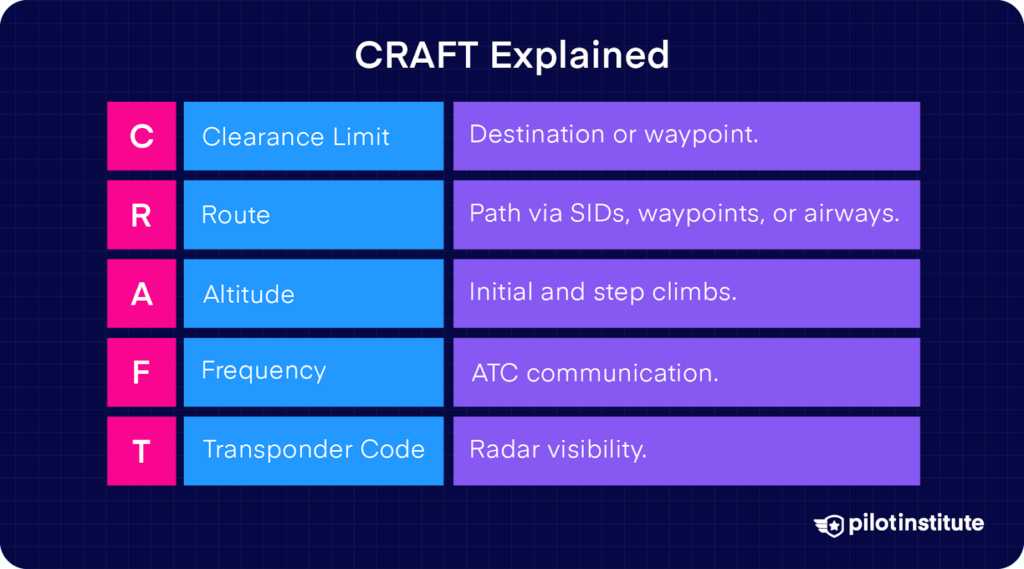
When the ATC gives your clearance, the information sometimes comes at you too much too quickly. There’s so much said in such a short time that you end up overwhelmed and lose track of your instructions.
Do you also have this problem? Here’s a better way to keep track of your clearances.
It’s called the CRAFT system. It’s an acronym where each letter corresponds to a portion of your clearance. Using this technique, you can break down and recall your IFR clearance with ease.
What does CRAFT mean? Each letter stands for:
- Clearance Limit
- Route
- Altitude
- Frequency
- Transponder Code
When you’re departing a busy airport on an IFR flight plan, having a system will keep you stay organized and consistent.
Let’s take a closer look at its five components:
C: Clearance Limit
The clearance limit is the farthest point you’re authorized to fly under the current clearance.
Most of the time, this will be your destination airport. But in some cases, ATC might only clear you to a specific fix or waypoint.
For example, during heavy traffic, ATC might say, “Cleared to XYZ via ABC intersection.” It means you must hold and await further instructions at the ABC intersection. Think of it as your temporary boundary.
R: Route
Your route is the path you’ll take to get to your clearance limit. It could involve:
- A standard instrument departure (SID).
- Designated waypoints.
- Airways.
- A direct flight path.
Imagine you’re departing from an airport with complicated procedures. How do pilots avoid chaos?
Having a clearly-outlined route will avoid confusion. Plus, it’ll ensure you’re following the flow of traffic planned by the ATC.
Always confirm that the route given matches your expectations or flight plan.
A: Altitude
Next, the ATC will assign an initial altitude for your departure. This can include instructions for step climbs as you go on your flight.
For example, you might hear, “Climb to 5,000 feet; expect FL200 ten minutes after departure.” Make a note of these altitudes and any following updates. The safe and efficient flow of traffic relies on good altitude management.
F: Frequency
Your assigned communication frequency is the lifeline that connects you to the ATC. You’ll need it to report your position, receive updates, and handle any changes en route.
Before takeoff, tune your radios to the correct frequency—whether it’s ground, departure, or center. Miscommunication here can lead to delays or missed instructions, so double-check this detail.
T: Transponder Code
The transponder code, or squawk code, is a four-digit identifier that makes your aircraft visible to ATC on radar.
For example, if you’re assigned a code like “4702,” enter it on your transponder. If ATC says, “Squawk ident,” press the ident button to highlight your position on their screen.
By breaking down your clearance using CRAFT, you can easily anticipate the information you’ll receive and read it back. It’s a small but powerful tool, so try it next time!
How To Use CRAFT in IFR Clearances
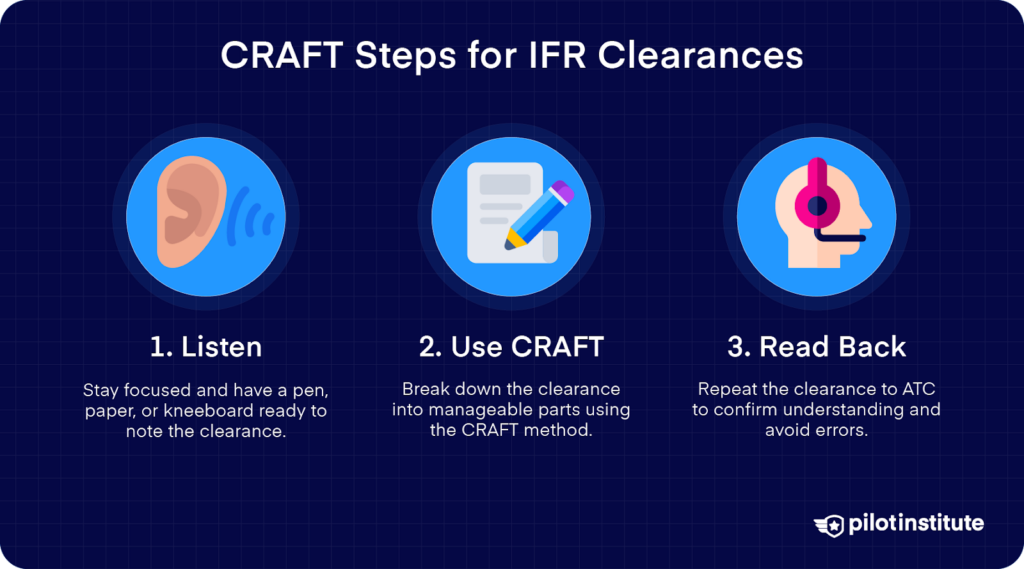
Understanding and decoding IFR clearances can feel overwhelming, but the CRAFT method simplifies the process. Wherever you’re flying from, this step-by-step approach helps you catch every detail and stay on track.
Let’s walk through how to use CRAFT when receiving your clearance.
Step 1: Listen Attentively
When ATC issues your IFR clearance, tune in carefully. Have a pen and paper or a kneeboard ready to jot down the details.
This will lower the chance of missing something important. It will also help organize your thoughts as you decode the clearance using CRAFT.
Want to try it out for yourself? Let’s use this example:
ATC: N123AB, cleared to XYZ airport via the ABC3 departure, direct DEF, climb and maintain 5,000, expect FL200 in ten minutes, departure frequency 120.5, squawk 4702.
Step 2: Decode Using CRAFT
Now, let’s break down this example into the five CRAFT components:
- Clearance Limit
First thing you’ll hear is your clearance limit, which is your authorized destination or holding fix. In this example, you’re cleared to XYZ airport. - Route
The route specifies how you’ll get to your clearance limit.
Here, it’s the ABC3 departure, followed by direct DEF. Review the departure procedures on your plates and check if they align with your flight plan.
- Altitude
Next, the ATC will assign an initial altitude and may give instructions for expected climb levels. In this case:- Climb and maintain 5,000 feet.
- Expect FL200 in ten minutes.
Always follow the initial altitude and be ready for any further updates.
- Frequency
After that, you’ll receive your communication frequency after takeoff. Here, it’s 120.5 for departure. Tune this into your radio before you even leave the ground. - Transponder Code
Lastly, the squawk code identifies your aircraft on ATC’s radar. In this example, it’s 4702. Input this into your transponder and ensure it’s set to ALT mode for proper altitude reporting.
Step 3: Read Back the Clearance
Once you’ve decoded the clearance, read it back to ATC exactly as given. This confirms that you understand your instructions and allows ATC to correct any misunderstandings.
Why Is CRAFT Important for Pilots?
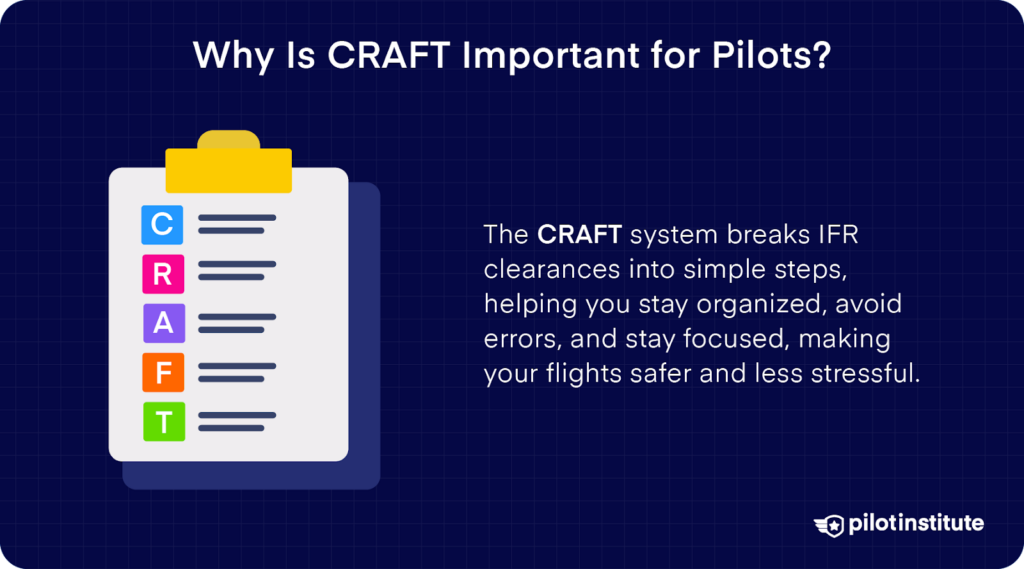
What are the pros of using this system?
Because it separates clearances into manageable pieces, the CRAFT method makes things easier to follow. And as a result, you’ll be less likely to make mistakes.
We all know a lot is happening before your departure, right? Errors will happen if you’re not organized, and they can have serious consequences. For example, missing a frequency change might leave you out of touch with ATC.
Even minor errors can disrupt traffic, which further adds to the stress for everyone involved.
CRAFT gives you a structured way to understand and confirm critical instructions. It helps you avoid these issues by turning complicated instructions into a clear, easy-to-follow checklist.
But using CRAFT isn’t just about following rules. Rather, it’s a way to stay safe and make your job much easier.
Knowing your clearance limit tells you how far you can fly, whether to a waypoint or your destination airport. When you understand the steps to get there, it’ll be easier for you to plan ahead.
This keeps you focused and ready for what’s coming next. When you’re on top of your flight, you’ll be less likely to feel overwhelmed.
Common Challenges When Using CRAFT
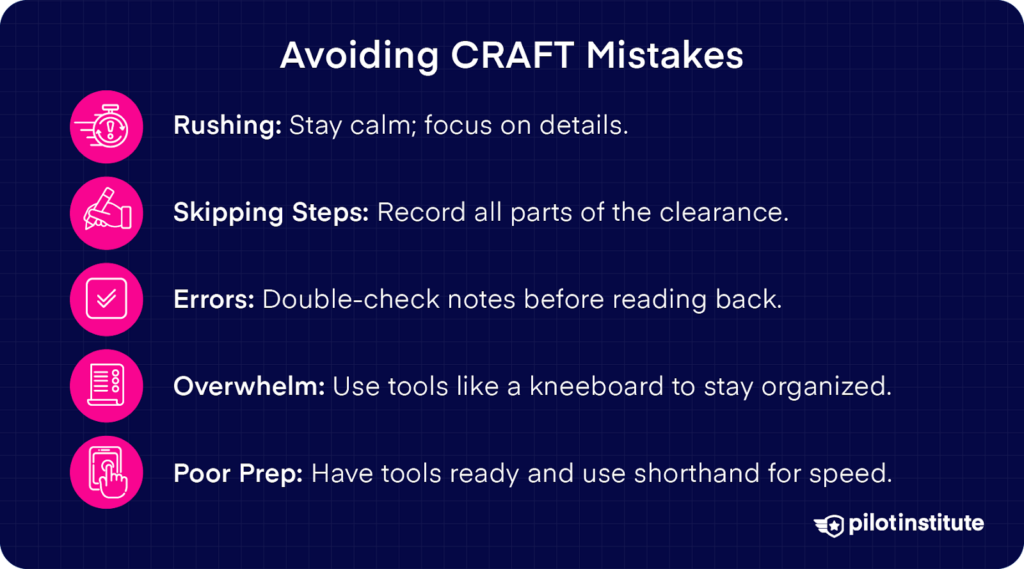
But while the CRAFT method is a great way to manage IFR clearances, like any tool, it’s not entirely foolproof.
You might face problems like rushing to note instructions, skipping steps, or struggling to stay organized. Although these mistakes happen occasionally, they can lead to bigger issues if left unchecked.
Common Mistakes Pilots Make
So, what errors should you watch out for? Being aware of these mistakes can help you avoid making them in the cockpit:
- Rushing through the clearance: The ATC often speaks quickly, and many pilots feel pressured to keep up. This can lead to missing details, like a waypoint or altitude assignment.
- Skipping steps: Forgetting one element of CRAFT, such as the transponder code or frequency, can create communication gaps.
- Errors during readback: Mispronouncing waypoints, swapping digits in frequencies, or using incorrect terms can confuse ATC.
- Getting overwhelmed: Juggling a clearance with other tasks, especially in busy airspace, can cause you to feel rattled and flustered.
- Poor preparation: Scrambling for tools or not having a system to record clearances sets you up for chaos from the start.
Tips To Improve Accuracy
These errors are typical, especially for new pilots. But with good habits, you can easily avoid them.
Preparation and focus are the best ways to improve clearance accuracy. Here are some simple tips to make sure you’re always ahead:
- Have tools ready: Always keep a pen, kneeboard, or notebook within reach. Have spaces pre-labeled for each part of the CRAFT acronym to make note-taking faster.
- Focus on key details: Pay close attention to the clearance limit, route, altitude, frequency, and transponder code. Ignore the filler words and focus only on what’s important.
- Repeat while writing: Say each part of the clearance to yourself as you write it down. This reinforces accuracy and reduces the chance of missing something.
Before reading the clearance back to ATC, take a moment to double-check your notes. Did you miss a few pieces or mix things up?
You might have made errors like reversed digits or unclear abbreviations. Make a careful scan of your notes before clicking on the mic.
During the readback, clear communication is just as important. Speak slowly, emphasize each element, and make sure ATC can easily confirm your understanding.
Don’t hesitate to ask for clarification if something doesn’t sound right. Even with preparation, challenges can pop up.
And if you miss a part of the clearance, stay calm and politely ask ATC to repeat it. Controllers would rather repeat a clearance than have it misunderstood.
Mastering the CRAFT Method
Aviation is both a science and an art; this is where your creativity comes in! Try to come up with your own shorthand system that works best for you.
For example, to speed up the note-taking process, try using shorthand or abbreviations, like “ALT 5,000” for “Climb and maintain 5,000 feet.”
Like anything in flying, CRAFT is a technique you can only master with experience. Practice using CRAFT before every IFR departure. Mistakes will happen occasionally, but it’s all part of the learning process.
When you use this method as part of your everyday flight routine, it eventually becomes second nature. And with every successful clearance, you build confidence and strengthen your ability to handle complex instructions!
Practical Example of CRAFT in Action
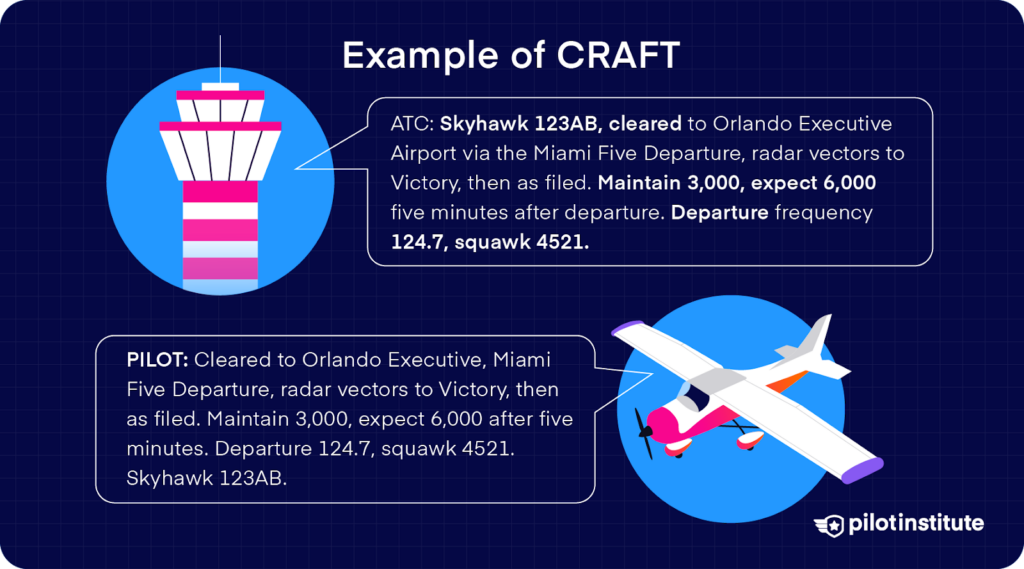
Understanding the CRAFT method is easier when you see it in action. So now, let’s walk through an example of an IFR clearance and break it down together.
Imagine a pilot, call sign Skyhawk 123AB, preparing to depart from Miami International (KMIA) to Orlando Executive (KORL) under IFR.
Remember the first step: listen attentively. Ready? Here’s the clearance:
ATC: Skyhawk 123AB, cleared to Orlando Executive Airport via the Miami Five Departure, radar vectors to Victory, then as filed. Maintain 3,000, expect 6,000 five minutes after departure. Departure frequency 124.7, squawk 4521.
Breaking It Down With CRAFT
Okay, let’s dissect this clearance using the CRAFT method:
- Clearance Limit: Orlando Executive Airport (KORL). This is the final destination to which the pilot is authorized to fly.
- Route: “Miami Five Departure, radar vectors to Victory, then as filed.” This outlines the aircraft’s path, including the departure procedure (Miami Five), radar vectors, and the en route portion (as filed in the flight plan).
- Altitude: “Maintain 3,000, expect 6,000 five minutes after departure.” You’ll begin at 3,000 feet and anticipate a climb to 6,000 feet five minutes after departure.
- Frequency: “Departure frequency 124.7.” This is the frequency of initial contact with departure control after takeoff.
- Transponder Code: “Squawk 4521.” This is the discrete transponder code for the flight, allowing ATC to identify the aircraft on radar.
Sample Dialogue
How will that sound on the radio? Let’s take a listen:
ATC: Skyhawk 123AB, cleared to Orlando Executive Airport via the Miami Five Departure, radar vectors to Victory, then as filed. Maintain 3,000, expect 6,000 five minutes after departure. Departure frequency 124.7, squawk 4521.
Pilot: Cleared to Orlando Executive, Miami Five Departure, radar vectors to Victory, then as filed. Maintain 3,000, expect 6,000 after five minutes. Departure 124.7, squawk 4521. Skyhawk 123AB.
Did you get it right? Remember to always tune in closely and take it one step at a time.
In practice, using CRAFT transforms what could be a stressful process into something manageable. It also builds good habits that improve communication and keep everyone in the airspace safer.
Every element of CRAFT works together to give you a clear, structured path from takeoff to en route operations.
Conclusion
CRAFT makes it so much easier to understand IFR clearances. With just five steps—Clearance, Route, Altitude, Frequency, and Transponder—you’ll have a clear plan every time you fly.
Remember, practice makes perfect! The more you use CRAFT, the more natural it will feel.
So, next time you’re preparing for a flight, give it a try!



